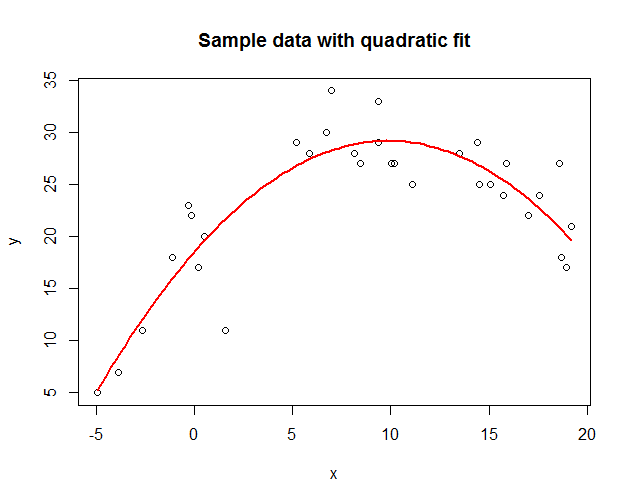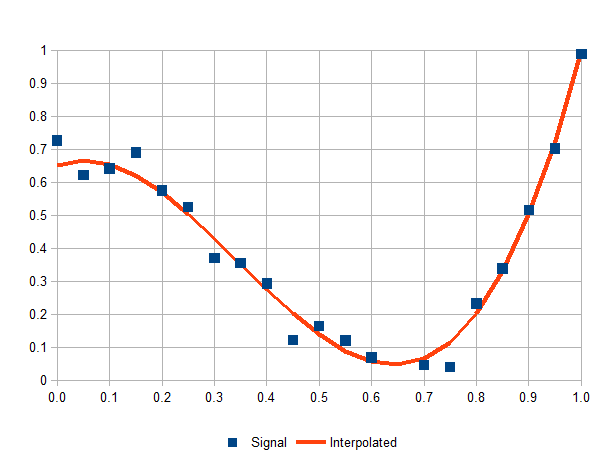Page 1 of 2
Polynomial curve fitting
Posted: Thu Jan 23, 2020 11:53 am
by mrcoollion
I am trying to build the best polynomial curve fitting lines/formula's from a number of X Y points
Has anybody done this before with LC ? Are there mathematical functions in LiveCode I can use for this (like in excel with LINEST or POLIFIT in Mathlab).
Or does anybody has some sample script available?
Regards,
Paul
Re: Polynomial curve fitting
Posted: Thu Jan 23, 2020 12:18 pm
by richmond62
Presumably you would have a polygon graphic
and you would set the points of your polynomial curve to that.
A few years ago I made a "spirograph" thing in LiveCode that did just that:
can't for the life of me think where it might be at the moment.

Re: Polynomial curve fitting
Posted: Thu Jan 23, 2020 1:09 pm
by mrcoollion
richmond62 wrote: ↑Thu Jan 23, 2020 12:18 pm
Presumably you would have a polygon graphic
and you would set the points of your polynomial curve to that.
A few years ago I made a "spirograph" thing in LiveCode that did just that:
can't for the life of me think where it might be at the moment.

Thanks for the reply R...
However, in my case I have many points (X,Y coordinates) and I want to get the best fitting line through those points.
This means I want to create a polynomial function that approximates a set of data points

- graphpoints.png (5.19 KiB) Viewed 12802 times

- PointsGraph2.gif (10.6 KiB) Viewed 12799 times
Re: Polynomial curve fitting
Posted: Thu Jan 23, 2020 1:14 pm
by richmond62
Presumably the polynomial function will "spit out" coordinates for your curve which can then
be used as the points for a graphic object.
Re: Polynomial curve fitting
Posted: Thu Jan 23, 2020 1:40 pm
by mrcoollion
richmond62 wrote: ↑Thu Jan 23, 2020 1:14 pm
Presumably the polynomial function will "spit out" coordinates for your curve which can then
be used as the points for a graphic object.
More or less...
I will be using the polynomial function to predict the next coordinate.
Re: Polynomial curve fitting
Posted: Thu Jan 23, 2020 9:47 pm
by richmond62
Pretty crude, but you get the point . . . .

Erm . . . hang on a mo' . . . the
points.

-
Re: Polynomial curve fitting
Posted: Thu Jan 23, 2020 11:07 pm
by dunbarx
Hermann.
Get in here.
Craig
Re: Polynomial curve fitting
Posted: Fri Jan 24, 2020 8:22 am
by [-hh]
First please read
https://en.wikipedia.org/wiki/Polynomial_regression
to understand that polynomial regression is a special case of multiple linear regression.
So all you essentially need is a fast handler for computing the inverse of the matrix X'X where X is given in the wiki above.
This is basic linear algebra and not hard to implement in LC.
[See for example the last code snippet here:
viewtopic.php?p=181709#p181709]
Note.
When computing polynomial fits for a degree > 3 you might run into rounding errors with LC. You could then use a bignum library of javascript via a browser widget or of python via shell).
Re: Polynomial curve fitting
Posted: Fri Jan 24, 2020 12:19 pm
by mrcoollion
I almost wracked my brain on it and it took me 2 days, but I made a working routine that calculates the Polynomial Coefficients up to a maximum of 7 degrees.

Is anybody interested in it also for testing?
I do think that LC should have some more mathematical functions available like this one, as most development languages have. Building this was not good for my blood pressure...

Let me know and I will post the code.

Re: Polynomial curve fitting
Posted: Fri Jan 24, 2020 1:34 pm
by [-hh]
Why do you ask if you already have a working routine? What a waste of time ...
Re: Polynomial curve fitting
Posted: Fri Jan 24, 2020 1:48 pm
by mrcoollion
I did not have a working routine.. I just build it.
Re: Polynomial curve fitting
Posted: Fri Jan 24, 2020 2:42 pm
by dunbarx
Hermann.
MrCoolion was in the process of working on his routine when he asked if anyone had already done something similar. This is not unusual. I have often stopped in the middle of a task to see if there is an existing solution somewhere.

Craig
Re: Polynomial curve fitting
Posted: Fri Jan 24, 2020 3:08 pm
by mrcoollion
Thanks Craig,
You gave me back the positive vibe of today. I will post my code in a few moments for anyone to use and audit

.
Regards,
Paul
Re: Polynomial curve fitting (Solved)
Posted: Fri Jan 24, 2020 3:28 pm
by mrcoollion
Here is the command with which one can determine the Polynomial Coefficients of a formula for curve fitting.
Copy>Paste the complete code in one button and have a look at the array OutPolCo at the breakpoint.
Command consists of following routines.
- Build a polynomial regression matrix for Xi (tXMatrix)
- Build the XiYi matrix (tYMatrix)
- Combine the Xi and XiYi matrixes into an augmented matrix for Gauss-Jordan elimination (tXMatrix)
- Do the Gauss-Jordan elimination on the augmented matrix (result is in taSolution)
Have fun with it..... And if you have any improvement please let me know and post them here.
Code: Select all
on mouseup
// See for conformation and information: https://arachnoid.com/sage/polynomial.html
put "-1,0,1,2,3,5,7,9" into InXCoordinates
put "-1,3,2.5,5,4,2,5,4" into InYCoordinates
put 4 into InDegrees
---- More test data
--put "0,1,2,3,4,5,6,7,8,9,10" into InXCoordinates // 4 test
--put "1,6,17,34,57,86,121,162,209,262,321" into InYCoordinates // 4 test
--put 2 into InDegrees / 4 test
------
CalcPolynomialCoefficients InDegrees,InXCoordinates,InYCoordinates,OutPolCo
------
breakpoint // See OutPolCo for the coefficients
end mouseup
command CalcPolynomialCoefficients InDegrees,InXCoordinates,InYCoordinates @OutPolCo
// See for conformation and information: https://arachnoid.com/sage/polynomial.html
--put "-1,0,1,2,3,5,7,9" into InXCoordinates // 4 test
--put "-1,3,2.5,5,4,2,5,4" into InYCoordinates // 4 test
-- put 4 into InDegrees // test
// Higest Aray number in OutPolCo gives the coefficient for the higest degree of X in a equation like y= a*X4+b*X3+c*X2+d*X+e
// In this case with the test numbers OutPolCo[5] is the coefficient for X4
-----------------------------------------------------------------------------------
put the number of items of InXCoordinates into tNumberOfXItems
put the number of items of InYCoordinates into tNumberOfYItems
if tNumberOfXItems <> tNumberOfYItems
then
answer "Amount of X and Y coordinates is not equal!"
exit CalcPolynomialCoefficients
end if
if InDegrees > 7
then
answer "Max number of degrees is 7. Larger polynomial degrees risk exceeding the resolution of the variables in use !"
exit CalcPolynomialCoefficients
end if
if tNumberOfXItems < InDegrees+1
then
answer "Need a minimum of " & InDegrees+1 & " sets of x,y coordinates!"
exit CalcPolynomialCoefficients
end if
---- fill X matrix -----------------------------------------
repeat with MVC = 1 to InDegrees+1
Repeat with MHC = 1 to InDegrees+1
if MVC=1 and MHC=1
then
put tNumberOfXItems into tSumXiP
else
put MVC+MHC-2 into tPower
repeat for each item tXi in InXCoordinates
--
put "put tXi^"&tPower&" into tXiP" into tScriptLine
do tScriptLine
--
add tXiP to tSumXiP
end repeat
end if
put tSumXiP into tXMatrix[MVC,MHC]
put 0 into tSumXiP
end Repeat
end repeat
-- Fill Y Matrix (MVC stands for Matrix Vertical Column)----
repeat with MVC = 1 to InDegrees+1
put 0 into tCounter
repeat for each item tYi in InYCoordinates
add 1 to tCounter
if MVC=1
then
add tYi to tSumXiPYi
else
put MVC-1 into tPower
put item tCounter of InXCoordinates into tXi
--
put "put tXi^"&tPower&" into tXiP" into tScriptLine
do tScriptLine
--
add tXiP*tYi to tSumXiPYi
end if
end repeat
put tSumXiPYi into tYMatrix[MVC]
put 0 into tSumXiPYi
end repeat
-- Combine matrixes by adding Y matix as last column to X matrix
-- creates an augmented matrix
repeat with MVC = 1 to InDegrees+1
put tYMatrix[MVC] into tXMatrix[MVC,InDegrees+2]
end repeat
----------------------------------------
// Gauss-Jordan elimination
put InDegrees+1 into tNbrRows
put InDegrees+2 into tNbrColumns
--
repeat with tColumnNbr = 1 to tNbrRows
repeat with tRowNbr = 1 to tNbrRows
if tColumnNbr <> tRowNbr
then
put tXMatrix[tRowNbr,tColumnNbr]/tXMatrix[tColumnNbr,tColumnNbr] into tCNumber
repeat with k =1 to tNbrColumns
put tXMatrix[tRowNbr,k]-tCNumber*tXMatrix[tColumnNbr,k] into tXMatrix[tRowNbr,k]
end repeat
end if
end repeat
end repeat
--
repeat with tRowNbr = 1 to tNbrRows
put tXMatrix[tRowNbr,tNbrRows+1]/tXMatrix[tRowNbr,tRowNbr]into taSolution[tRowNbr]
end repeat
------------------------------------------
put taSolution into OutPolCo
end CalcPolynomialCoefficients
Re: Polynomial curve fitting
Posted: Fri Jan 24, 2020 7:52 pm
by [-hh]
This is the well known polysolve algorithm (which is the general linear model solution specialized for the polygonial hypothesis).
See an online computation (incl. your example and a graphical output) for example here:
https://arachnoid.com/polysolve/index.html
Now you translated that algorithm to LC, fine, well done!
Sadly, the problem with that (and generally with using LC for advanced statistical computations) is that you may get
tremendous rounding errors when using floating point math (as LC does), depending on the dataset and the degree of the polynomial.
This is for example described in "popular" math wording on the above page at the bottom in section
"Technical notes and limits".
That's why some people who need that don't use LC but a program that can handle bignums (as mathematica, matlab, sage, ..., python).